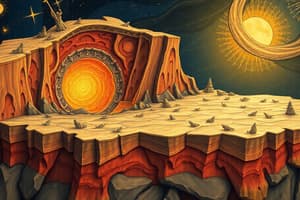Podcast
Questions and Answers
What are the two main types of crust found on Earth?
What are the two main types of crust found on Earth?
Continental Crust and Oceanic Crust
What drives the movement of Earth's lithospheric plates?
What drives the movement of Earth's lithospheric plates?
Mantle convection cells
What is the main difference between the outer core and inner core?
What is the main difference between the outer core and inner core?
The outer core is liquid, while the inner core is solid
What is the process known as when plates move apart, creating gaps filled by new material at spreading ridges?
What is the process known as when plates move apart, creating gaps filled by new material at spreading ridges?
What are the three types of plate boundaries?
What are the three types of plate boundaries?
What is the characteristic of a linear feature at a divergent plate boundary?
What is the characteristic of a linear feature at a divergent plate boundary?
What happens to the denser oceanic crust at an oceanic-continental convergent plate boundary?
What happens to the denser oceanic crust at an oceanic-continental convergent plate boundary?
What is the characteristic of a hotspot volcano?
What is the characteristic of a hotspot volcano?
What is the process that occurs when two plates pull apart at a divergent plate boundary?
What is the process that occurs when two plates pull apart at a divergent plate boundary?
What is the characteristic of the boundary between two continental plates at a convergent plate boundary?
What is the characteristic of the boundary between two continental plates at a convergent plate boundary?
Flashcards are hidden until you start studying
Study Notes
Types of Crust
- Continental crust is thick, composed of silica and aluminum (SIAL), and has a lower density (lighter)
- Oceanic crust is thin, composed of silica and magnesium, and has a higher density (heavier)
Mantle
- Lies between the Earth's crust and core
- Composed primarily of silicate minerals rich in iron and magnesium
- Extends to a depth of about 2,900 kilometers (1,800 miles)
- Temperature and pressure increase with depth
- Divided into the upper mantle and lower mantle
- Uppermost part of the mantle and crust is called the lithosphere
- Partially molten in the asthenosphere (upper mantle)
Mantle Convection Cells
- Circular patterns of movement within the mantle caused by heat transfer
- Hot, less dense material rises from deep within the mantle
- Cooler, denser material sinks towards the mantle's interior
- Drive plate tectonics and the movement of Earth's lithospheric plates
- Responsible for geological phenomena such as earthquakes, volcanic activity, and mountain formation
Core
- Innermost Earth layer
- Outer Core: liquid iron and nickel, generates Earth's magnetic field
- Inner Core: solid iron and nickel, extremely high temperatures and pressures
Plate Tectonics
- Earth's crust divided into 12 major plates
- Plates move in various directions
- Plate motion leads to collisions, divergence, and scraping against each other
- Different interactions cause characteristic tectonic features
- "Tectonic" refers to crust deformation due to plate interaction
- Lithospheric plates moved by underlying mantle convection cells
Plate Boundaries
-
Three types of plate boundaries: divergent, convergent, and transform
-
Divergent Plate Boundaries:
- Spreading Ridges: plates move apart, creating gaps filled by new material
- Constructive Boundaries: generate new crust
- Types of Divergent Boundaries:
- Oceanic Divergent Boundaries: form mid-oceanic ridges (e.g., Ocean ridges)
- Continental Divergent Boundaries: form rift valleys or block mountains (e.g., African Rift Valley, Iceland's rift)
- Linear Feature: exists between two tectonic plates moving away from each other
- Volcanic Activity: plates pull apart, allowing hot molten material to rise to the surface
-
Convergent Plate Boundaries:
- Oceanic-Continental Crust Convergence: denser oceanic crust subducts under continental crust
- Oceanic-Oceanic Crust Convergence: one oceanic plate subducts under the other, forming a subduction zone
- Continental-Continental Crust Convergence: both continental plates push against each other, forming high mountain ranges and fold mountains
-
Transform Plate Boundaries:
- Plates slide past each other
- Example: San Andreas Fault near San Francisco (boundary between the Pacific Plate and the North American Plate)
Volcanoes and Plate Tectonics
- Hotspot Volcanoes:
- Location on the Earth's surface with long-term active volcanism
- Caused by a mantle plume rising from near the core-mantle boundary
- Independent of tectonic plate boundaries
- Example: Hawaiian Island chain
- Subduction:
- Occurs where a denser plate slides under a less dense plate into the mantle
- Common at transform or convergent boundaries
- Subducting slab dehydrates, forming new melt that rises and erupts at the surface
- Rifting:
- Happens when two plates pull apart...
Studying That Suits You
Use AI to generate personalized quizzes and flashcards to suit your learning preferences.




